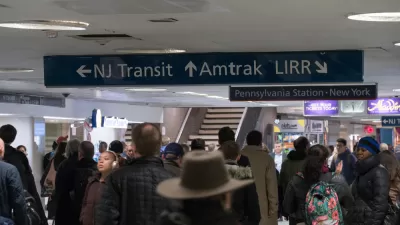Considered by some to be the most critical infrastructure project in the country, the Gateway Project is an ongoing example of the extreme costs of bureaucratic and political neglect.

The Gateway Development Commission, tasked with managing the Gateway Program to develop new capacity for the Northeast Corridor between Newark, New Jersey and Penn Station in New York City, announced at the end of August that the project will open three years later than expected and cost $2 billion more to construct.
Officials blamed some of the delay and expense on “market volatility and inflation,” according to an article by Dana Rubinstein for the New York Times. “The commission hopes to make up much of the cost difference with funding from the federal infrastructure law passed last year. The remaining cost overrun will be split between New York and New Jersey and the federal government.”
The news is only the latest unwelcome development in the long saga of the Gateway Program. Since the Biden administration took office, the news has generally been good—funding approval for the Portal Bridge and a $14 billion funding agreement between the states of New Jersey and New York. The last time Planetizen picked up news of time and money being added to the project timeline was in September 2020.
Rubinstein includes a discussion of the high costs of transit infrastructure investments in the article, citing Eric Goldwyn, director of the Transportation and Land-Use program at the N.Y.U. Marron Institute, to explain how expensive is the project compared to other projects in the country and world. The Marron Institute produced the first study on the high cost of transit in 2021.
FULL STORY: Commuter Tunnel Under the Hudson Won’t Be Finished Until 2035

Alabama: Trump Terminates Settlements for Black Communities Harmed By Raw Sewage
Trump deemed the landmark civil rights agreement “illegal DEI and environmental justice policy.”

Planetizen Federal Action Tracker
A weekly monitor of how Trump’s orders and actions are impacting planners and planning in America.

The 120 Year Old Tiny Home Villages That Sheltered San Francisco’s Earthquake Refugees
More than a century ago, San Francisco mobilized to house thousands of residents displaced by the 1906 earthquake. Could their strategy offer a model for the present?

Ken Jennings Launches Transit Web Series
The Jeopardy champ wants you to ride public transit.

BLM To Rescind Public Lands Rule
The change will downgrade conservation, once again putting federal land at risk for mining and other extractive uses.

Indy Neighborhood Group Builds Temporary Multi-Use Path
Community members, aided in part by funding from the city, repurposed a vehicle lane to create a protected bike and pedestrian path for the summer season.
Urban Design for Planners 1: Software Tools
This six-course series explores essential urban design concepts using open source software and equips planners with the tools they need to participate fully in the urban design process.
Planning for Universal Design
Learn the tools for implementing Universal Design in planning regulations.
Clanton & Associates, Inc.
Jessamine County Fiscal Court
Institute for Housing and Urban Development Studies (IHS)
City of Grandview
Harvard GSD Executive Education
Toledo-Lucas County Plan Commissions
Salt Lake City
NYU Wagner Graduate School of Public Service





























